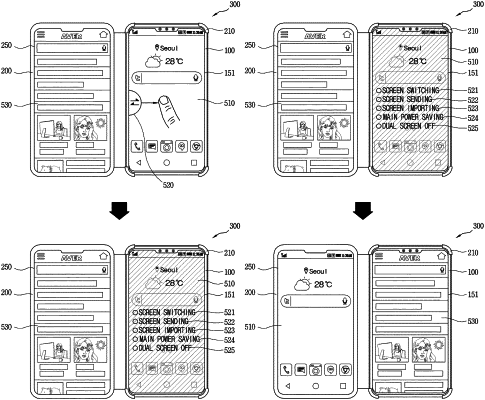| CPC H04M 1/0214 (2013.01) [G06F 3/0488 (2013.01); G06F 3/04817 (2013.01); G06F 3/04847 (2013.01); G06F 3/1423 (2013.01); H04B 1/3888 (2013.01); H04M 1/21 (2013.01); H04N 9/73 (2013.01); H04N 23/632 (2023.01); H04M 2201/38 (2013.01)] | 16 Claims |

|
1. An electronic device comprising a mobile terminal and a case to which the mobile terminal is coupled,
wherein the mobile terminal comprises:
a terminal body coupled to the case; and
a first display unit coupled to the case,
wherein the case comprises:
a first body to accommodate at least a portion of the terminal body;
a second body on which a second display unit is disposed;
a wiring part electrically connecting the first body and the second body to transmit data received from the mobile terminal to the second display unit; and
a wireless communication unit connected to the wiring part to transmit and receive signals to and from the mobile terminal,
wherein the first and second display units have one of a closed state in which the first display unit is covered by the second display unit and an open state in which the first display unit is not covered by the second display unit,
wherein a control unit of the mobile terminal is configured to:
set an execution screen in an initial state for the second display unit to store as setting information of the second display unit,
detect that the closed state is switched to the open state according to a relative rotation of the first body and the second body, and switch the first display unit from an inactive state to an active state,
display a home screen on the first display unit when switched from the inactive state to the active state of the first body and the second body,
determine whether a touch input corresponds to a preset touch input applied to the second display unit, generate a control signal for switching the second display unit to the active state, transmit the generated control signal to the second display unit with data associated with the stored setting information, and display the set execution screen on the second display unit,
detect a state in which an execution screen of a first application is displayed on the first display unit, and an execution screen of a second application is displayed on the second display unit,
control, when a touch signal of a first touch applied to the execution screen of the first application is received, the execution screen of the first application by transmitting a first control signal corresponding to the touch signal of the first touch to the first display unit, and
control, when a touch signal of a second touch applied to the execution screen of the second application is received, the execution screen displayed on the second display unit by transmitting a second control signal corresponding to the received touch signal of the second touch to the second display unit through the wireless communication unit and the wiring part, and
wherein the first control signal and the second control signal are provided to the first display unit and the second display unit, respectively, via separate communication routes so that operations corresponding to the first and second control signals are performed simultaneously without affecting each other.
|
|
11. A method for controlling an electronic device including a mobile terminal and a case to which the mobile terminal is coupled, wherein the mobile terminal comprises a first display unit, and the case comprises a first body to accommodate the mobile terminal and a second body on which a second display unit is disposed, and wherein the first and second display units have one of a closed state in which the first display unit is covered by the second display unit and an open state in which the first display unit is not covered by the second display unit,
the method comprising:
setting an execution screen in an initial state for the second display unit to store as setting information of the second display unit;
detecting that the closed state is switched to the open state according to a relative rotation of the first body and the second body, and switching the first display unit from an inactive state to an active state;
displaying a home screen on the first display unit when switched from the inactive state to the active state of the first body and the second body;
determining whether a touch input corresponds to a preset touch input applied to the second display unit, generating a control signal for switching the second display unit to the active state, transmitting the generated control signal to the second display unit with data associated with the stored setting information, and displaying the set execution screen on the second display unit;
detecting a state in which an execution screen of a first application is displayed on the first display unit, and an execution screen of a second application is displayed on the second display unit;
controlling, when a touch signal of a first touch applied to the execution screen of the first application is received, the execution screen of the first application by transmitting a first control signal corresponding to the touch signal of the first touch to the first display unit; and
controlling, when a touch signal of a second touch applied to the execution screen of the second application is received, the execution screen displayed on the second display unit by transmitting a second control signal corresponding to the received touch signal of the second touch to the second display unit,
wherein the first control signal and the second control signal are provided to the first display unit and the second display unit, respectively, via separate communication routes so that operations corresponding to the first and second control signals are performed simultaneously without affecting each other.
|